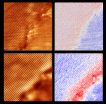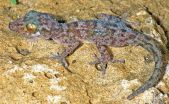(Press-News.org) OAK RIDGE, Tenn., Nov. 10, 2014--Scientists at the Department of Energy's Oak Ridge National Laboratory have made the first direct observations of a one-dimensional boundary separating two different, atom-thin materials, enabling studies of long-theorized phenomena at these interfaces.
Theorists have predicted the existence of intriguing properties at one-dimensional (1-D) boundaries between two crystalline components, but experimental verification has eluded researchers because atomically precise 1-D interfaces are difficult to construct.
"While many theoretical studies of such 1-D interfaces predict striking behaviors, in our work we have provided the first experimental validation of those interface properties," said ORNL's An-Ping Li.
The new Nature Communications study builds on work by ORNL and University of Tennessee scientists published in Science earlier this year that introduced a method to grow different two-dimensional materials -- graphene and boron nitride -- into a single layer only one atom thick.
The team's materials growth technique unlocked the ability to study the 1-D boundary and its electronic properties in atomic resolution. Using scanning tunneling microscopy, spectroscopy and density-functional calculations, the researchers first obtained a comprehensive picture of spatial and energetic distributions of the 1-D interface states.
"In three-dimensional (3-D) systems, the interface is embedded so you cannot get a real-space view of the complete interface -- you can only look at a projection of that plane," said Jewook Park, ORNL postdoctoral researcher and the lead author of the work. "In our case, the 1-D interface is completely accessible to real-space study,"
"The combination of scanning tunneling microscopy and the first principles theory calculations allows us to distinguish the chemical nature of the boundary and evaluate the effects of orbital hybridization at the junction," said ORNL's Mina Yoon, a theorist on the team.
The researchers' observations revealed a highly confined electric field at the interface and provided an opportunity to investigate an intriguing phenomenon known as a "polar catastrophe," which occurs in 3-D oxide interfaces. This effect can cause atomic and electron reorganization at the interface to compensate for the electrostatic field resulting from materials' different polarities.
"This is the first time we have been able to study the polar discontinuity effect in a 1-D boundary," Li said.
Although the researchers focused on gaining a fundamental understanding of the system, they note their study could culminate in applications that take advantage of the 1-D interface.
"For instance, the 1-D chain of electrons could be exploited to pass a current along the boundary," Li said. "It could be useful for electronics, especially for ultra-thin or flexible devices."
The team plans to continue examining different aspects of the boundary including its magnetic properties and the effect of its supporting substrate.
INFORMATION:
The study is published as "Spatially resolved one-dimensional boundary states in graphene-hexagonal boron nitride planar heterostructures." Coauthors are ORNL's Jewook Park, Jaekwang Lee, Corentin Durand, Changwon Park, Bobby Sumpter, Arthur Baddorf, Mina Yoon and An-Ping Li; the University of Tennessee's Lei Liu, Ali Mohsin, and Gong Gu; and Central Methodist University's Kendal Clark.
This research was conducted in part at the Center for Nanophase Materials Sciences and the National Energy Research Scientific Computing Center, both DOE Office of Science User Facilities. The research was supported by DOE's Office of Science, ORNL's Laboratory Directed Research and Development program, the National Science Foundation and DARPA.
ORNL is managed by UT-Battelle for the Department of Energy's Office of Science. DOE's Office of Science is the single largest supporter of basic research in the physical sciences in the United States, and is working to address some of the most pressing challenges of our time. For more information, please visit http://science.energy.gov.
Image: http://www.ornl.gov/Image%20Library/Main%20Nav/ORNL/News/News%20Releases/2014/anping_2_hr.jpg?code=6ba934c7-cf5b-45c9-8de2-5ba33bd0593b
Caption: Scientists at the Oak Ridge National Laboratory have made the first direct observations of the electronic behaviors of a one-dimensional boundary separating atom-thin graphene and hexagonal boron nitride materials.
NOTE TO EDITORS: You may read other press releases from Oak Ridge National Laboratory or learn more about the lab at http://www.ornl.gov/news. Additional information about ORNL is available at the sites below:
Twitter - http://twitter.com/ornl
RSS Feeds - http://www.ornl.gov/ornlhome/rss_feeds.shtml
Flickr - http://www.flickr.com/photos/oakridgelab
YouTube - http://www.youtube.com/user/OakRidgeNationalLab
LinkedIn - http://www.linkedin.com/companies/oak-ridge-national-laboratory
Facebook - http://www.facebook.com/Oak.Ridge.National.Laboratory
Autoimmune diseases like Crohn's Disease and multiple sclerosis, in which the immune system attacks its own body rather than predatory invaders, affect 5-20% of the global community. A study published recently in Autoimmunity Reviews by Prof. Yehuda Shoenfeld, the Laura Schwarz-Kipp Chair for Research of Autoimmune Diseases at Tel Aviv University's Sackler Faculty of Medicine and Head of Zabludowicz Center for Autoimmune Diseases at Chaim Sheba Medical Center, Tel Hashomer, points to the major role obesity plays in triggering and prolonging these autoimmune diseases.
According ...
Stanford, CA--Photosynthesis is probably the most well-known aspect of plant biochemistry. It enables plants, algae, and select bacteria to transform the energy from sunlight during the daytime into chemical energy in the form of sugars and starches (as well as oils and proteins), and it involves taking in carbon dioxide from the air and releasing oxygen derived from water molecules. Photosynthetic organisms undergo other types of biochemical reactions at night, when they generate energy by breaking down those sugars and starches that were stored during the day.
Cells ...
A team of scientists has published the most comprehensive picture yet of how acidity levels vary across the world's oceans, providing a benchmark for years to come as enormous amounts of human-caused carbon emissions continue to wind up at sea.
"We have established a global standard for future changes to be measured," said Taro Takahashi, a geochemist at Columbia's Lamont-Doherty Earth Observatory who published the maps with his colleagues in the August issue of the journal Marine Chemistry. The maps provide a monthly look at how ocean acidity rises and falls by season ...
Research scientists at VTT Technical Research Centre of Finland have demonstrated a new technique for generating electrical energy. The new method can be used in harvesting energy from mechanical vibrations of the environment and converting it into electricity. Energy harvesters are needed, for example, in wireless self-powered sensors and medical implants, where they could ultimately replace batteries. In the future, energy harvesters can open up new opportunities in many application areas such as wearable electronics.
Research scientists at VTT have successfully generated ...
New Rochelle, NY, November 10, 2014--To understand their risk for hereditary forms of cancer, such as breast and colon cancer, women need to know their family history. The design and effectiveness of a 20-minute skills-based intervention that can help women better communicate with relatives and gather and share information about cancer family history is described in a study in Journal of Women's Health, a peer-reviewed publication from Mary Ann Liebert, Inc., publishers. The article is available free on the Journal of Women's Health website at http://online.liebertpub.com/doi/full/10.1089/jwh.2014.4754 ...
A new drug combination for rheumatoid arthritis treats the disease just as well as other intensive treatment strategies but with less medication and fewer side effects at a significantly lower cost. Doctoral researcher Diederik De Cock (KU Leuven) describes the strategy in a new study published in Annals of Rheumatic Diseases.
Rheumatoid arthritis (RA) is a chronic auto-immune disease that causes pain and stiffness in the joints, fatigue, bone damage and, eventually, loss of mobility. RA afflicts around 1% of people in the western world; in Belgium, 80,000 to 100,000 ...
Hidden away in the tropical darkness of nocturnal Madagascar, scientists have discovered a new species of gecko which has been described in the open access journal Zoosystematics and Evolution.
A master of disguise, the new species Paroedura hordiesi has camouflage pattern to blend with its natural habitat, while climbing on rocks and the ruins of an old fort, where it was spotted by scientists.
Home of the new gecko, the karstic limestone massifs in the region of northern Madagascar are believed to still harbour further undescribed reptile species, some of which might ...
BOSTON - The innate immune system serves as the body's specialized armed forces division, comprised of a host of defense mechanisms used to battle bacterial infections. Among the system's warriors are white blood cells including the specialized macrophages, which maintain constant surveillance for foreign intruders or pathogens, functioning as the body's first line of defense, poised to attack at barrier sites including the skin, lungs and intestines.
Now, a research team led by investigators at Beth Israel Deaconess Medical Center (BIDMC) finds that naturally occurring ...
Recognizing the emotions other people feel is crucial for establishing proper interpersonal relations. To do so, we look at (amongst other things) facial expressions and body posture. Unfortunately, in some neurological disorders this ability is heavily impaired. This happens, for example, in multiple sclerosis where scientific evidence shows that people affected by the disease often have trouble recognizing expressions that communicate emotions. A new study now demonstrates that the same difficulty may also be encountered with emotions conveyed by posture. In addition, ...
A newly identified signaling pathway that stimulates glucose uptake in brown fat cells might be useful for treating type 2 diabetes and obesity, according to a study in The Journal of Cell Biology.
When the body encounters cold temperatures, the sympathetic nervous system activates adrenoceptors on the surface of brown fat cells to stimulate glucose uptake from the bloodstream. Brown fat cells then use this glucose as a fuel source to generate body heat. Glucose uptake also can be induced by insulin. However, although insulin-stimulated glucose-uptake is well understood, ...




